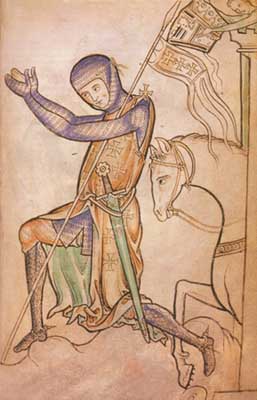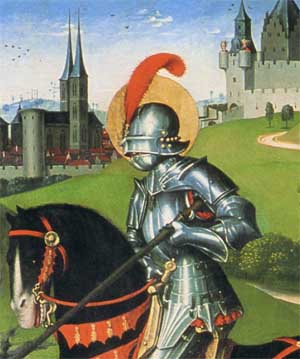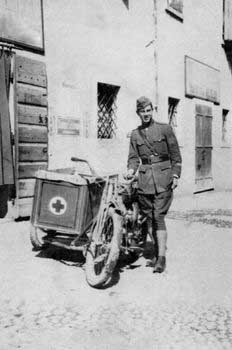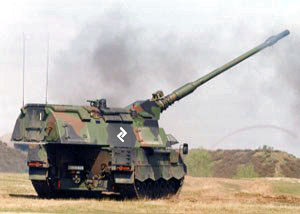  HistoryMap of Friland (opens in new window) Summary Elaborate history of Friland Prehistory: Prehistory is everything that happened before historiography began. In many European countries prehistory therefore ends with the arrival of the Romans and the texts they wrote about the country. Because Friland was never occupied by the Romans written history starts relatively late there. The first inhabitants of Friland Although the Frilanders are regarded as the first inhabitants of the archipelago, there is regular discussion about this. Flint tools found in Swik (Friland) and Quartier (Hiveria) are dated by some archaeologists before the arrival of the Frilanders. Some sagas mention a primitive people called Raudfarwars ("Red dyers") as the original inhabitants. They covered themselves with red ocher and were excellent hunters. However, they are also described as giant and skilled in magic. It is therefore difficult to distinguish between historiography and mythology. According to the Gaburdabok, a historic text from the 8th century, Friland was discovered in the year that Alexander the Great died (323 BC). Although this is hard to verify, carbon datings of archeological findings on Friland confirm that the first human inhabitants of the island indeed arrived in the 4th century BC. The Gaburdabok mentions that a trading vessel lead by a man named Maginaharduz was traveling from Norway to Ireland, which was a dangerous undertaking with the primitive ships of that time. Near the Orkney islands a heavy storm blew the ship off course. After having floated at sea for a long time, Maginaharduz and his men reached the coast. Convinced that they were in Ireland the merchandise was unloaded and the men went searching for the nearest village, but they quickly found out that they had discovered an unknown land. They returned to Norway to notify their tribesmen. Their tribe called itself the "Frijoz" (the Free). Due to overpopulation and food shortage the Frijoz were engaged in a war for farmland with neighbouring tribes. The newly found island solved all the problems at once and was therefore regarded to be a gift from the gods. The Frijoz made peace with their neighbours and decided that half of them would go to the new land. The group that left was lead by a warlord named Sturaldiz. When the fleet reached the new land after a long journey they called it "Frijalandam" (the Free Land), or "Friland" in the current language. Not far from the beach a settlement was founded with the name Neujastadiz, which, according to the descriptions of the Gaburdabok, must have laid at the coast of modern Riksga. On the same day the enthusiastic colonists proclaimed Sturaldiz the first king of Friland. The Norwegian origin of the Frilanders was confirmed by genetic research in 1998. There are also strong similarities between the pottery that was made in Friland and Norway in that time. Archeological excavations show that Friland was a relatively quiet and peaceful country in the centuries after the colonization. While on mainland Europe the Romans founded an empire, the Huns took Eastern Europe and the Great Migrations ended the classic world, far away Friland was spared from all this clashing of arms. Despite its isolated position there was booming trade with the British islands, Scandinavia and the mainland. There were strong bonds with related tribes in Scandinavia and the river areas of the Netherlands and Germany. From them the Frilanders took over innovations like stirrups, runic writing and ironworking techniques. 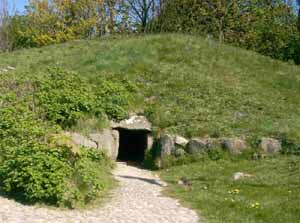 Prehistoric tomb in the Nebulwalț In the 5th century the Anglo-Saxons settled in England, which, according to the Gaburdabok, caused a division in Friland: on one hand people had sympathy for the Anglo-Saxons, with whom the Frilanders had a close friendship, but on the other hand the Briton tribes whose land they had invaded were very important trading partners. A neutral stance was chosen, which preserved the friendship with both parties. Nevertheless some noble families openly sided with the Anglo-Saxons or the Britons, which lead to mutual conflicts between the neutrals, the supporters of the Saxons and the supporters of the Britons. Especially the conflict between the last two often moved from the political arena to the real battlefield. 8th century: The reforms of Gisalberht In the 8th century things were written down for the first time. In the century before short runic inscriptions were already carved into every day objects, but these texts were never longer than one or two lines and mostly consisted of religious incantations or information about the owner or maker of the object. King Gisalberht, nicknamed "the Changer", decided to create a Frilandic literary tradition and ordered that the oral history of Friland had to be written down. The result was the Gadedskrift ("History writing"), which was written by Țunarstain Harmodssun. Eventually the king also started limiting the powers of the nobility and started governmental reforms. The changes that king Gisalberht caused were very sensitive in conservative Friland: when he eventually suggested to replace the runes with Latin writing the people decided that he went too far and deposed him. 9th century: Vikings and missionaries The Vikings colonized Iceland and the Faeroe Islands, they also reached Friland and Ireland. Although there were raids and plundering from time to time Friland was mostly spared because of the strong friendship bonds it had with Scandinavia, the homeland of the Vikings. Especially along the south coast of Walamark the Vikings founded a number of peaceful settlements from where they traded with the Frilandic population. The city of Eldsida also used to be such a settlement. The Vikings offered isolated Friland a window on the world and lots of new inventions reached the curious islanders. The 9th century is also characterized by the arrival of Irish missionaries, who didn't make themselves popular with their attempts to convert the Frilanders to Christendom. Especially because their "body guards" did not refrain from using violence for this purpose. When a missionary named Conlaed chopped down a holy oak near Arnstad and used the wood to build a chapel for saint Paul he and his soldiers were captured by an angry mob and sacrificed to the god they had insulted. That human sacrifices had already been banned for quite some time was simply ignored for this occasion. Not long thereafter a folk assembly was held in which it was decided that the missionaries were not longer welcome. 10th century: The Irish invasions The Viking chieftain Egill Langbarđr scourged the south coast of Riksga, especially Arinhaim was plundered many times. In the year 956 Egill drowned when his ship was sunk during a battle on the Flautar. 963 is the year in which the "Iriska enfallan" (Irish invasions) started; due to civil wars in Ireland many people there decided to leave their country and, just like the Vikings, settle on the south coast of Walamark. In the course of years this led to conflicts with both the Frilanders and the Vikings because the settling didn't always go peacefully. Things really got out of hand when the Irish warlord Muirtigern decided to occupy southern Walamark and found a new Irish kingdom there. For the Frilandic king Segmer this was the last straw: he raised an army and after a hard struggle he managed to defeat Muirtigern in 986, after a reign of only one and a half year. After the victory king Segmer offered a choice to both the Vikings and the Irish: those who stopped waging war and conformed to the Frilandic laws, had nothing to fear from him and would be allowed full Frilandic citizenship. Those who refused had to leave the country or face him on the battlefield. Because Segmer was a powerful man the biggest troublemakers decided to leave the country, those who stayed behind became good Frilandic citizens.
Æthelric flees to Friland William the Conqueror invaded England and on October 14, 1066 he defeated the Anglo-Saxon king Harold Godwinson in the battle of Hastings. The relationship between Friland and the new, Norman England deteriorated because Friland openly supported the Anglo-Saxons. Two sons and a daughter of Harold Godwinson escaped via Ireland to Denmark. Æthelric Haroldson, another son of Harold, fled via Ireland to Friland. As the son of the befriended king he was received with open arms. Æthelric adopted the Frilandic name "Ațalrik Harwaldssun" and married a Frilandic lady. From their seven children a new noble family sprang forth; the Harwaldungan, named after their famous forefather Harold. The founding of Hiveria William the Conqueror was furious that Friland had offered shelter to the fled son of Harold and declared war on Friland. In 1078 he sent an army to Friland that was lead by the nobleman Guy le Breton. Guys army landed near modern Fort de Guy on January 23, 1078. Because it was unusual to undertake such a large invasion in winter the Frilanders were completely unprepared. The eastern part of modern Heunia, then still called Hamulga ("Stone shire"), was easily taken due to the surprise attack. Because of heavy snowfall the Norman soldiers named the conquered land Terre d'Hiver ("Winterland"), which soon corrupted to Hiveria. Guy le Breton was declared duke of the new Hiveria, during which he swore to submit all of Friland to his rule. In Friland queen Swențgard tried to rally the nobles to retake the lost territory and drive the Normans back into the sea, but mutual division about the strategy ended in quarrels, which caused precious time to be lost. First Frilandic-Hiverian War In 1079, a year after the invasion, Hiveria started a large offensive inland. All of Hamulga (Heunia) was conquered with ease and Guys army moved northwards past the Haupik until it reached the Innansai. Because of this Danab, back then still called Dunga ("Dune shire"), was completely cut off from the rest of Friland. Again queen Swențgard tried to build up a noteworthy opposition against Hiverian expansionism, but due to the bickering nobles and hopeless division she didn't succeed in that. With an army that was way too small she left Riksgard, determined to bring the Hiverians to a halt. The strategic value of this deed has often been discussed, but it is argued that queen Swențgard wanted to set an example to move the quarreling Frilanders to unity. The battle of Algsmar On July 21, 1079 both armies met near Algsmar, a village east of the Haupik. Swențgards army consisted of three hundred of her bodyguards, two units of archers and a couple hundred hastily rallied peasants. Guys army was twice as big and consisted of well-equipped knights, archers and footmen. Swențgard positioned her army on top of a steep ridge, which forced Guys soldiers to fight upwards along a narrow path while numerous arrows rained down upon them. The Hiverian army suffered heavy losses and Guy stopped the attack. Under cover of dense fog he ordered a part of his army to outflank the Frilanders while he launched another attack over the narrow path. Because of that the Frilanders fully concentrated on the path and didn't notice that the rest of the Hiverian army approached them from the rear. The Frilanders were cornered and suffered such heavy losses that the battle was decided within a few minutes. When queen Swențgard allowed her bodyguards to bring themselves to safety, they refused. 'No Frilander should relinquish the soil of his ancestors without a fight; we will accompany you to the hall of the gods,' spoke Wulfgaiz, the highest officer of the royal bodyguard. Swențgard and 180 of her remaining bodyguards positioned themselves in a circle on the highest point of the ridge; their backs against each other, surrounded from all sides. The entire Hiverian army ran up the ridge and stormed the group. The Frilanders grimly stood their ground and the bodies piled up. Only when Hiverian knights managed to break through the circle everything was lost; wounded and weary Swențgard saw her last men fall, then she threw herself into her sword. Thus died the queen of the Frilanders on the battlefield of Algsmar. After the battle Guy burned down the village of Algsmar and returned in triumph to St. Gérard. The First Frilandic-Hiverian War had turned into a disaster for Friland. 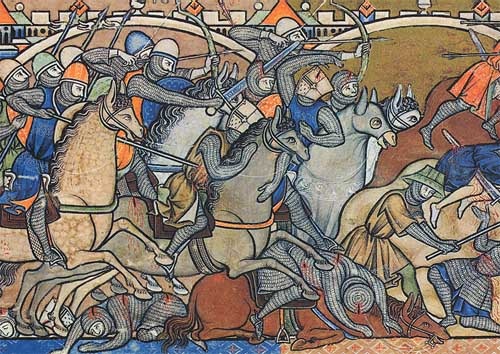 The battle of Algsmar Events in Hiveria While the Frilandic nobles waged war on each other, Hiveria expanded its power over the occupied territories. French, the Norman court language, became the official language of Hiveria and served as a lingua franca to bridge the many French, English and Frilandic dialects in the country. This has remained the case to this day. Catholicism was made the only religion. Guy also promised pope Innocent II that he would convert all of Friland to Catholicism, which stirred an outrage in non-Christian Friland. With lots of money and political support from the pope Guy sent missionaries to all corners of Friland, where most of them had little success and in some cases even ended up as a bog body. Guy also decided to translate the Bible into Frilandic. This first translation was simply called "ța Frilandiska Bibal" (the Frilandic Bible) and is even still used by Frilandic Christians today. Guy le Breton died on November 4, 1134; he was interred in the chapel of saint Bonifatius in Fort de Guy. His son and successor Thierry was imprisoned after false accusations by count Lothaire d'Alençon, who subsequently became duke himself. Although Guy had already been ignoring his Norman liege in England a lot, Lothaire even went a step further: he openly behaved as if he was the king of an independent Hiveria, instead of a mere duke who had to answer to the Norman king. When a civil war broke out in England, Lothaire seized the opportunity and proclaimed himself king of Hiveria on March 6, 1139. Hiveria was now an independent country. Second Frilandic-Hiverian War King Lothaire hadn't forgotten about Guys promise to the pope: because the stubborn Frilanders kept refusing to convert to Christendom he decided to force them. He contacted the pope for money and support, after which he formed an army that did not only consist of Hiverians but also of English, French and Spanish volunteers. Although the Second Frilandic-Hiverian War is not counted amongst the official crusades, it can definitely be regarded as such. In that time Christendom had spread to most of Europe and even the proud Vikings had already been forced to give up their heathen religion over a century ago. Friland was a last remnant of the old, heathen world and the pope didn't like that one bit. On May 10, 1142 the crusading army crossed the border between Hiveria and Friland. Poverty-stricken, isolated Dunga (Danab) was not able to defend itself and was completely occupied. The majority of Frilandic nobles fled the area to prevent being burned at the stake. Earl Wighard Hludwigssun saved himself by being baptized in the cathedral of St. Gérard, he was rewarded with a big sum of money and king Lothaire made him duke of the new Hiverian province of Danab. After the easy victory in Danab the crusading army moved westwards and took the Austanburg (these days Château l'Est), the entry gate to Walamark, after a short but fierce fight. Control of the Austanburg allowed them to cross the Rițar (Ruisseau) without opposition and take the city of Sugila (Solaria). The Frilandic army in Walamark was dealt a crushing defeat and large parts of the area were taken. Eventually the crusading army even marched into the city of Spirdung; it looked like all of Walamark was lost. However, the Frilandic population of occupied East Walamark revolted en masse and managed to drive the occupiers out of Sugila. This forced the crusading army to return and relinquish Spirdung. Multiple skirmishes took place and countless victims fell, especially amongst the rebellious civilians, who were slaughtered in large numbers by the crusading knights. Because of the delay the Frilandic king Tiswald managed to reach Walamark with a small and hastily raised army. He met the crusading army east of Storlau, modern Grand Forêt. The battle of Storlau The Frilandic army was much smaller than the Hiverian army and mainly consisted of volunteers from Riksga and Medga and rebels from Walamark, who had joined them on the way. The crusading army almost fully consisted of knights on horseback, who had left the archers and footmen behind in order not to lose any time. Tattered Frilandic farmers were facing the elite of European knighthood, who were equipped with iron harnesses, swords, lances and horses. However, king Tiswald knew how to exploit the one-sided compilation of the crusading army: he ordered his men to make long spears, after which he placed them in dense rows and made them form a shield wall, from which the numerous long spears protruded like a pin cushion. When the crusading knights charged, they and their horses were impaled. The skulls of the survivors were crushed with axes. After a few hours the dead knights were piled up almost half a meter high, the few survivors fled the battlefield. In Europe people held their breath; for the first time in history a heathen people had managed to withstand the mighty crusaders. Further course of the war Because a part of the crusading army was still intact, king Tiswald decided to retake the Austanburg as quickly as possible to cut off the retreat of the crusading army and to prevent that reinforcements could be sent from Hiveria. At midnight, in dense fog, he stormed the Austanburg and succeeded in defeating the totally surprised defenders. Walamark was saved: the remnant of the crusading army had been trapped behind the Rițar and fell apart in chaos. New reinforcements from Friland took care of them. However, there was no reason to celebrate: all Frilandic territories east of the Rițar had been lost. Because of the Second Frilandic-Hiverian War Hiveria had grown twice as large; the many Frilanders who now lived within her borders were forced to convert to Catholicism. Those who refused were expulsed or killed. Nevertheless the Second Frilandic-Hiverian War is not seen as a total defeat in Friland, where the people proudly commemorate the fact that Friland is the only European country that managed to preserve its native beliefs. 13th century: The hibernation In Iceland the Poetic Edda and Proza Edda were written, which inspired Frilandic writers to record their sagas as well. The result was the Aiț, the Frilandic saga book of which the name is derived from Old Norse "Edda". In this time the Raginkwed ("Words of the gods") was also written, which is a religious book in which the words of several gods were written down. The tension between Friland and Hiveria remained but apart from some small skirmishes this didn't escalate into an open conflict. The positional system (the "Arab numbers") was introduced in Hiveria and Friland, after it came over from the British isles. Because of the lack of important events the 13th century is also called the "wentarslep" (hibernation) in Friland. Tensions and discord increased due to increasing poverty, which caused the nobility to take over control in many places and for a long time there was no king. This situation lasted until the 15th century, when king Țeudrik reunited the country. 14th century: Isolation In 1337 the Hundred Years' War broke out between England and France, both Friland and Hiveria remained neutral. In 1347 Europe was hit by the plague, in which a third of the European population died. Sheer terror caused Friland and Hiveria to remain in isolation for years, in which the overseas trade was also halted. Although these measures prevented the plague from spreading to the Frilandic islands, they did result in a huge economic crisis that both countries couldn't overcome until the end of the century. Hiveria annexes Walamark on April 9, 1386 Fulkmer Karskung Țeudmanssun, duke of Walamark, married the Hiverian princess Arabelle d'Alençon. In itself this wasn't such a problem, except for the fact that she was the daughter of Montaigu d'Alençon, a descendant of Lothaire d'Alençon and the king of Hiveria. Because of the marriage Montaigu regarded all of Walamark as Hiverian property from that day forward, because Fulkmer was now a part of the Hiverian royal family and his territory (everything between the Rițar and the Skimferț) therefore automatically became part of the crown as well. In Friland they thought this reasoning was pure nonsense but the naive duke Fulkmer was nothing more than a pawn in the hands of king Montaigu. On April 11, 1386 Hiverian troops entered Walamark unopposed. Less than a day later both the English and the French king made it known that Walamark had been rightfully added to the Hiverian crown and that Friland could better not interfere with this matter. In Friland it became clear that behind the screens a dirty trick had been played on them by some very high ranking people, but every attempt to regain Walamark got bogged down in endless diplomatic squabbling.
The Frilandic golden age In order not to stay behind on scientific and technological terrain Țeudrik, the king at the time, regularly sent people to the mainland to study there. Trade also went well for Friland, which resulted in a century of unprecedented wealth. After the disastrous defeats against Hiveria the Frilandic army was reorganized: besides the people's army (Fulkshar) a professional army (Rikshar) was created, as well as a unit of elite forces who were called the "Sturmridars" (Storm knights). A bigger unity was also forged in Friland and the government was further centralized. King Țeudrik limited the power of nobility and allowed more rights to the citizens. Friland was starting to become a modern, prosperous country that counted in the world. Third Frilandic-Hiverian War In Friland the Walamark-issue had still not been forgotten: after many fruitless attempts to regain the area through diplomatic ways, military action was decided on March 17, 1448. In the Riksțing this was preceded by harsh debates because it could possibly conflict with the "Ni airista hriț" (No first attack) -policy, which prescribed that Friland was never allowed to start a war first. After a long and heated debate it was decided that the attack was justified because Hiveria had unrightfully occupied Frilandic territory by military means. With the Riksțing's permission, king Țeudrik crossed the Skimferț with an army of 12.000 men. In Spirdung he was enthusiastically received by the people, who had single-handedly thrown the handful of Hiverian defenders outside the city walls. From Spirdung Țeudrik moved on to Runsburg but near Dannanwalț he met the Hiverian army. The battle of Dannanwalț On March 24, 1448 both armies met on a field near the village of Dannanwalț. King Țeudrik positioned his troops in a double row: archers at the back and spearmen at the front. On the flanks he placed Sturmridars. The Hiverian army was almost twice as big and was led by the skilled general Ancel Joubert. Joubert was very convinced of his victory and ordered his troops to move towards the Frilanders on the double, hoping to demoralize or even rout them. This turned out to be a miscalculation because his crossbowmen had difficulties aiming while walking. Meanwhile, the Frilandic archers unleashed a rain of arrows upon them. Right before the two armies made contact king Țeudrik ordered the Sturmridars to conduct a pincer movement from the flanks: they galloped outwards to get past the incoming enemy, moved towards each other behind them and then attacked them in the back. This caused great panic, which made the formation of the Hiverian army fall apart. Only Joubert and a number of his most loyal men tried to hold their ground, but the main army routed. The Frilanders followed them until the bulk of the army had been annihilated. After the battle king Țeudrik found the body of Joubert amongst the fallen; he had lost both the battle and his life, but the general's heroic deeds had won the respect of his Frilandic adversaries. The liberation of Walamark After the victory at Dannanwalț Țeudrik liberated Runsburg and broke through to Sugila. Outside the city skirmishes with Hiverian troops took place, but at the end of the afternoon these surrendered and Țeudrik was able to enter the city. The next objective was the Austanburg, where the Hiverians had left a strong garrison. Under a rain of arrows, stones, litter and boiling oil the Frilanders climbed the walls with ladders and siege towers. King Țeudrik made himself immortal by being the first to climb onto the wall and leading his men in the battle. After a fierce fight a number of knights managed to open the gate; the Frilanders all streamed into the castle. The Hiverian commander, who had barricaded himself in the keep with his men, then waved a white flag. After taking their weapons king Țeudrik allowed them an unopposed withdrawal, thereafter he moved onwards. On March 30, 1448 the Frilandic army reached the Rițar; Walamark was liberated! 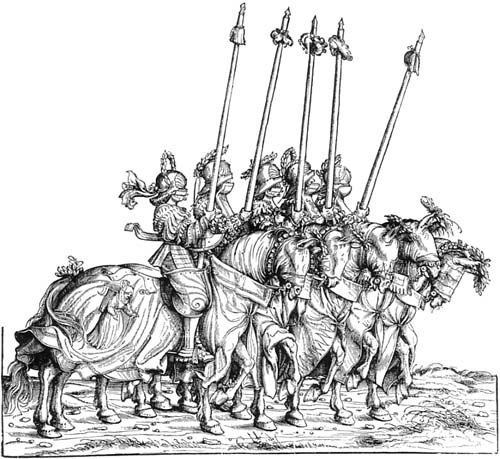 Victory parade of Sturmridars in liberated Sugila When the Hiverian king Anthoine d'Alençon received tidings about the loss of Walamark, he became furious. He immediately traveled to the city of Heunia, the westernmost bulwark of the Hiverian army, to take charge of the campaigns personally and raise a new army. To revenge his defeat he decided that the popular king Țeudrik had to be disposed of, especially because even the people in Hiveria started to admire the brave Țeudrik. On April 10, 1448 three Hiverian assassins managed to sneak past security and gain access to the tent of king Țeudrik. The valorous king, who had defeated numerous opponents on the battlefield, was cowardly assassinated in his sleep. The battle of Champmarron The Frilanders were enraged about the dishonourable assassination of their king. The new king, Țeudrik's son Bloțwulf, swore vengeance. At the head of his fathers army he crossed the Rițar on April 18, 1448 and met the new army of king Anthoine near Champmarron, a hamlet west of Heunia. Bloțwulf ordered his troops to attack in wedge formation, which caused the Hiverian army to be split in two right at the beginning of the battle. The fanaticism with which the raging Bloțwulf went berserk on his enemies was legendary, because of which the Hiverians gave him the nickname "Le loup-garou" (The werewolf). Although the Hiverian army was larger than the Frilandic one, the battle-rage of the Frilanders completely wiped it off the map within an hour. To thank for the victory, the weapons that were taken after the battle were sacrificed to Wodan, the god of war. In this event a number of high-ranking prisoners is rumoured to have been ritually strangled. The siege of Heunia and the death of king Antoine The fury of king Bloțwulf had still not cooled; he marched on to the city of Heunia, where the Hiverian king resided. He surrounded the city to prevent Antoine from escaping. Hereafter he brought in siege equipment and cannons to reduce the entire city to rubble. For three days trebuchets slung their bullets against the walls and cannons roared, until Heunia surrendered on April 22, 1448. King Anthoine tried to flee the city disguised as a beggar, but he was recognized and brought before Bloțwulf. According to the Hiverian chronicle "l'Histoire de Troisième Guerre" the way in which Anthoine was killed by Bloțwulf was so vicious, that it wasn't appropriate to mention it... The peace of Louisville Because Anthoine d'Alençon had no sons, the d'Alençon dynasty had ended. He was succeeded by Anfroi Concarneau. The new king tried to keep the damage as limited as possible; his land was in chaos and the immense fear of Bloțwulf had caused entire cities to flee. With the chivalrous Țeudrik he could have negotiated, but Bloțwulf had made it known that he wouldn't stop until all Hiverians had been driven into the sea. King Anfroi decided to contact the Frilandic Riksțing, which had more than enough of Bloțwulfs ruthless actions. Peace talks were started and Bloțwulf, who had shortly before brought in extra cannons to wipe out St. Gérard, reluctantly obeyed the order to cease hostilities. On May 14, 1448 the peace treaty that ended the Third Frilandic-Hiverian War was signed in the royal cottage in Louisville. The aftermath of the war King Anfroi agreed with the formal return of Walamark and the high reparations imposed on his country. Although peace had been signed, the hatred between Friland and Hiveria had only grown stronger. King Bloțwulf held a victory parade in the capital Riksgard, where his actions in Hiveria had incited mixed reactions: in conservative circles he received a hero's welcome, but he was also criticized for his unscrupulous battle tactics. Not long after the war the economy blossomed as never before and art and architecture received a new impulse. The 15th century is rightfully known as Frilands golden age. 16th century: The Renaissance The 16th century is marked by the birth of Humanism. Although this movement never gained strong support in Friland, it did result in more room for the individual and the Frilandic juridical system was adapted to the norms of the time. In Hiveria Humanism gained a much stronger presence; especially amongst the civilians, who started to grow weary of the oftentimes very dominant nobility. The call for more rights became increasingly louder. Freedom of religion The ideas of Luther and Calvin gained support amongst the Christian minority in Friland, which resulted in the founding of the "Frilandisk Edstifta Kirik" (Frilandic Reformed Church). Just like Ireland, the Irish community in South Walamark remained Catholic. On September 6, 1570 the Riksțing decided that there would be freedom of religion, something that was only allowed much later in the rest of Europe. The new freedom of religion lead to unrest because the majority of the Frilanders was a supporter of the native religion, also known as "Ferna Sed" (the old tradition) or "Haițandom" (Heathendom). The anxiety for the Christian conversion urge ran deep and it was feared that the freedom of religion would be abused to attempt a large scale Christianization of Friland yet again. The Riksțing therefore decided a change of law that prohibited the active conversion of people: only those who went to a house of prayer of their own accord could be informed about the religion that was practiced there. Everyone was allowed to express his or her religion in public, but not actively spread it or force it onto others; so going from door to door or approaching people on the streets and shoving a bible under their noses was not allowed. The citizens had been reassured and all religious communities that were present in Friland agreed with the arrangement, which has been in effect to the current day. The Reformation in Hiveria In strictly Catholic Hiveria the Reformation was received less enthusiastically; king Auguinare Concarneau even allowed an inquisition to persecute everyone who deviated from "the one true faith". It started a witch hunt after heretics, in which torture and murder weren't shunned. At the end of the century the Reformation in Hiveria had faded away. The sea battle near Gennung The Barbary pirates, who had been scourging the Mediterranean for centuries from their bulwarks in North Africa, started to expand their operations to the northern part of the Atlantic Ocean. Before the coast of Friland they even captured the complete crew of a Portuguese ship and sold them on the market of Algiers. In 1591 a Barbary fleet led by the feared captain Wahid al-Jamil ibn Yazeed reached the coast of Friland. They attacked the city of Gennung, where princess Anghild was residing at the moment. She and 35 inhabitants of the city were taken hostage to be sold as slaves to the Ottoman sultan Murat III, who had taken an interest in the pretty 22-year-old daughter of king Erilgast. Even though the main part of the Frilandic fleet was practicing at the Innansai at the moment, there were still 13 warships at Lindan. As fast as possible Erilgast sailed these to Gennung, where he managed to intercept the fleet of Wahid al-Jamil on August 26, 1591. The pirates had a big advantage in numbers with their 28 ships. The cannons started firing and both fleets received direct hits. After an hour the pirates had lost two ships but the Frilandic fleet had suffered much heavier damage: one ship exploded, two ships were on fire and seven others were taking in water. The largest ship of the fleet, the "Saihangist" (Sea stallion), was boarded and captured. The remaining ships managed to rescue king Erilgast from the water just in time and withdrew to the harbour of Stordam. The king could do nothing more than watch how the Barbary pirates disappeared on the horizon with his daughter. The sea battle near Cape Cornwall In 1593 Erilgast got a chance to take vengeance: the fleet of Wahid al-Jamil had been spotted at the English coast near Plymouth. He decided not to waste time and sailed to the Channel with a fleet of 38 ships. Near Cape Cornwall he stumbled upon the Barbary pirates. The Frilandic ships had put about and fired broadside. After two and a half hours the English Royal Navy, who also had a bone to pick with the pirates, arrived from the east to offer assistance. The pirates were no match for these two combined forces: the strong fleet of Wahid al-Jamil disappeared beneath the waves. Wahid himself was taken prisoner and chained to the mast of his sinking ship by king Erilgast. While enjoying some captured rum the Frilandic sailors watched how Wahid and his ship disappeared under water. The terror of the notorious pirate had ended, but the beloved princess Anghild would never again return to her native country. 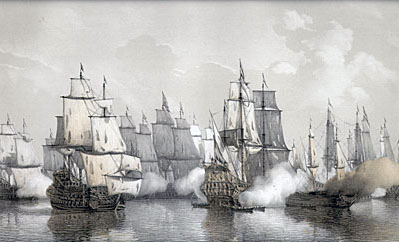 The sea battle near Cape Cornwall The Enlightenment in Friland During the 17th century the Enlightenment reached Friland, especially the rationalism connected thereto gained big support on the islands. Also on religious terrain a rationalization took place: where people first literally believed in the image of a god throwing thunderbolts and flying through the air in a chariot pulled by billy goats, they then started believing that the gods would perhaps not look like humans but would be some sort of invisible powers instead. Agnosticism and atheism became socially accepted viewpoints and science blossomed as never before. The Enlightenment in Hiveria In Hiveria the Enlightenment caused a greater sense of self-awareness amongst the civilian population. Where they used to accept the unlimited power of the nobles without protest, the call for more civil rights became increasingly louder. In the poor neighbourhoods of St. Gérard uproars broke out that could barely be contained by the Gendarme. The Enlightenment had incited ideas amongst the Hiverian people that would not simply disappear again. Colonialism Friland undertook many journeys of trade and exploration, which resulted in some overseas territories. From 1620 to 1961 there was also a semi-colonial presence in the African country of Kumanga, of which modern day Frilandic Kumanga is a remnant. However, this area has never formally belonged to the Kingdom of Friland. There were also many small trading posts, mainly for buying goods from the natives. For example in Zawiyah. However, a dark chapter of Frilandic history is the DWU ("Dreugshans fur Waldskapan Ubarsai" or Trading Company for Oversea Domains), an early multinational that had trading posts in Russia (Winaland) and Asia (Sandjau). These "trading posts" were in reality some kind of company colonies, where the DWU conducted slavery, oppression and other things that were frowned upon in Friland itself. However, in its oversea domains, where Frilandic law did not exist, it could do whatever it wanted. The DWU was founded in 1625 and went bankrupt in 1800. After this, the state refused to take over control of the DWU colonies, causing these to become independent and later cease to exist. Hiveria founded the colonies of Santo Phelipe and Isla Albero in the Caribbean and Esrayette and Kumanga in West Africa. Conflict with the pope On November 17, 1680 pope Innocent XI visited Hiveria and Friland. While in St. Gérard he highly praised the Catholic Hiverians, but in Riksgard he kept complaining about the godless Frilanders and their unchristian lifestyle. There were even three women in the cabinet, outrageous! King Raginwald, who had grown weary of the complaining, then calmly remarked that "uncivilized" Friland at least didn't persecute people of different religions. The pope furiously broke off his visit and got on the first ship back to Rome. The already not so smashing relationship between Friland and the Vatican had only gotten worse because of the visit. It would take over a century before Friland was honoured with a papal visit again... 18th century: Slave trade While in Friland slavery had already fallen into disuse a couple of centuries ago, slave trade became an important source of income in Hiveria. Hiverian traders bought as many slaves as they could at the African coast and shipped these to America. In Hiveria itself large numbers of Africans were also put to work, especially on the fields. This became so common that in 1750 an estimated 15% of the Hiverian population consisted of slaves. The Hiverian revolution Because of the strong bonds between Hiveria and France the French revolution of 1789 came as a bombshell. The brewing unrest amongst the Hiverian people reached a climax in 1794: through the entire country revolts broke out, which mainly targeted the monarchy and the nobility. Castles and palaces went up in flames, barons and marquises lost their head under the guillotine and royalist mayors were deposed. King Charles Concarneau used the army to quell the rebellion by force, but large parts of it defected to the rebels. On July 28, 1794 an angry mob dragged king Charles out of his palace and executed him and his family in front of the city hall of St. Gérard. On August 1, 1794 the Conceil Révolutionnaire (Revolutionary Council) appointed Guillaume Gaudin as the first president of the republic of Hiveria. 19th century: Romanticism During the early 19th century Romanticism found its way to Friland: the longing for the past, the revaluation of art, the "back to nature" and the striving for conservation of the own cultural identity were received with open arms in Friland. Especially because of the increasing threat from neighbouring Hiveria, which was busy reforming its army. The idea that humans are a part of nature instead of standing above it also had strong roots in mainly non-Christian Friland. Romanticism fit in well with the already existing ideas. The England crisis In the 19th century the British empire controlled almost one quarter of the world. The Victorians therefore proudly spoke about "The Empire on which the sun never sets". Because of her convenient position between America and Europe Friland had grown into a rich trading nation, but because of this strategic position the British had also laid their eyes on the archipelago. The British crown asked for extensive trading rights in Friland and later started adding the most impossible demands to that. The Riksțing realized that the British intentionally came with unacceptable demands in order to steer towards war. Since a war with the powerful British empire could not be won, it was decided to use all possible means to end what was already being called the "Anglandfreg" (England crisis) in Friland. On March 7, 1878 queen Algunț had a meeting with the British queen Victoria, in which the matter was discussed. The pretty and very intelligent Algunț left a permanent impression during her visit, with which she created a lot of sympathy amongst the British for that weird, self-willed island folk in the Atlantic Ocean. One week later Lord Ingsbury visited the Riksțing on behalf of queen Victoria to further discuss the matter. Eventually the crisis could be ended by diplomatic means: the British dropped their unreasonable demands and in return they received control over the village of Mekilhusan at the Frilandic coast for 50 years, which became a British crown colony. Although small Friland had to make a humiliating knee fall for the mighty British empire, it did succeed in preventing a potential invasion. The England crisis did damage the relations between Friland and the British empire. In the years thereafter Mekilhusan started to play an important role in the trade to America and the city was soon called "Tommy's point", after the British governour Sir Thomas Oxney. Frederic Alvare becomes dictator of Hiveria In Hiveria a power struggle broke out within the revolutionary party, which was won by general Frederic Alvare. On June 4, 1880 Alvare became president, after which he pulled all power to himself. The freedoms that the revolution had brought were simply revoked. Just like his great example Napoleon Bonaparte Alvare wanted to rule over a large empire. That Alvares limitless ambitions would eventually lead to a conflict with Friland, was inevitable. 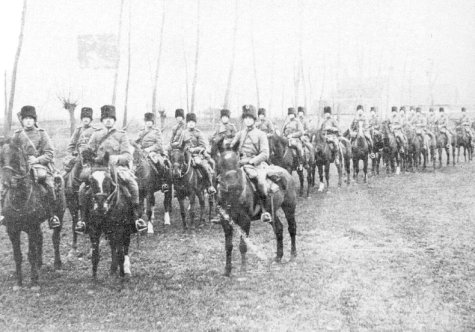 Frilandic cavalry on the battlefield near Risaur, May 16, 1881 Completely unexpected, the Hiverian army crossed the Rițar on May 9, 1881 and captured the Austanburg without a fight; a bribed Frilandic peasant had poisoned the defenders and opened the gate. The official reason for the invasion was that Frilandic soldiers had fired shots at the Hiverian border town of Ferme-sur-Glaise. Although this explanation was hardly believed by anyone, Alvare continued the invasion and occupied Sugila. The Frilandic army launched a counter-offensive near Runsburg. After days of mutual shelling the battlefield turned into a muddy moon landscape. Combined attacks of infantry and cavalry resulted in great losses on both sides. Eventually they entrenched themselves; the Fourth Frilandic-Hiverian War was a precursor of what would happen in the First World War, but few learned from the happenings on the remote archipelago. The war dragged on and several charges on each others trenches resulted in nothing but more dead. There was a stalemate that none of the sides could break. 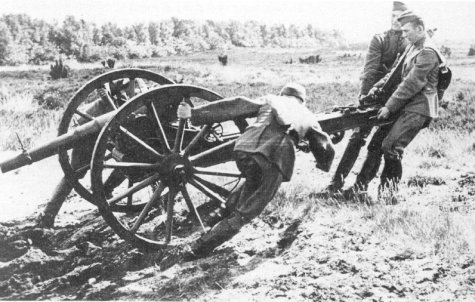 Artillery east of Runsburg, June 8, 1881 The British empire, which decided that the war was harmful to her trade, intervened and forced a peace uti possidetis ("as is in possession"). The frontline between Friland and Hiveria would become the new border, which was a big disadvantage for Friland because it meant that Walamark would be divided into a Frilandic part (the west) and a Hiverian part (the east), which was called "Solaria" in Hiveria and "Aust-Walamark" in Friland. The city of Runsburg, where the frontline ran right through, was also divided in two. An unstable peace The peace treaty was a bitter disappointment to both Friland and Hiveria: Alvare had wanted more and Friland considered all of Walamark hers. Despite this, the situation as it was wouldn't change anymore; until today the Runsburg-border forms the division between Friland and Hiveria, which is still one of the main reasons for the tensions between the two countries. In 1883 Frederic Alvare steered towards a war with Friland yet again, but before he could execute his plans he died of a heart attack. Persistent rumours that he was poisoned by the British have never been proven, though the documentary "Skeir afta Alwares daud" (Research after Alvares death) found strong clues for this in 1993. Alvares successor was Maurice Jaquin, who started a democratization process. Abolition of slavery Although slavery had been in disuse for centuries in Friland, it had never been formally abolished. Therefore the Riksțing decided to install the "Țrahilanban" (Slave ban) in 1884, which abolished slavery in all its forms. In Friland, where no slaves were held anyway, people simply shrugged over it. In Hiveria and its colonies however, this seemingly unimportant fact caused unrest amongst the many African slaves. They reasoned that if Friland abolished slavery, perhaps Hiveria might do that too. The result was that an increasing number of slaves called for their release. When president Jaquin started thinking about doing this, he got the agricultural sector and the landlords against him. Only when Jaquin decided to reimburse them the way was open for full abolition of slavery. The freed slaves still didn't get the same rights as other Hiverians though: they were put away in ghettos, had no right to education and were refused at the door in many shops and restaurants. 20th century: First World War When the First World War broke out in 1914, both Friland and Hiveria declared themselves neutral. Despite from two violations of the territorial waters by a lost German submarine and an English cruiser, the First World War went silently past Friland and Hiveria. The roaring 20's In 1920 the quiet town of Westarhult on the island of Langmark became world news for a short period: a local chicken farmer named Storgaiz Harwenssun proclaimed himself king of the city. With a pitch-fork he went to the city hall and chased out the city council, which the amassed citizens had lots of fun about. Storgaiz then converted the city hall into his personal palace, started a harem of twenty women and built a zoo with elephants and camels in the city center. After a while the Riksțing had enough of the display and ended the circus: "king" Storgaiz was dragged out of his palace by the police and sentenced to a few years in prison. However, the real Frilandic king thought it was pretty funny and decided to offer his rival clemency a month later, who then returned to his chickens and promised never to conduct another coup. In 1999 the event was used for the film "Kunung Storgaizland". In 1928 the British crown colony Tommy's Point (Mekilhusan) was returned to Friland again. After mutual state visits there was a considerable improvement of the Frilandic-British relations. Second World War
Although Friland is known for its strict asylum policy, it did make an exception during the war and accepted refugees, mainly Jewish people. Some of them were allowed to stay in Friland after the war, where they developed into a blossoming community. Many of the big cities in Riksga therefore have a synagogue. Uproar in the Hiverian colonies The war was followed by decolonisation. In the Hiverian colonies the call for independence also became increasingly louder. On December 10, 1960 Isla Albero, a Hiverian colony in the Caribbean, declared its independence. President Yves Boutrebois reacted by sending the army to restore order in the rebellious colony. Marc Quichet, the leader of this army, went way too far with this and caused a massacre in the village of Bahía del Palma. The international community decided to put heavy pressure on Hiveria to end the war. Because of the scandal president Boutrebois resigned; his successor Jacques Lejeune allowed Isla Albero its independence. Two other colonies, Santo Phelipe in the Caribbean and Kumanga in West Africa, followed a year later. After Hiveria had also pulled out of there, the situation there got terribly out of hand and a bloody power struggle broke out between rival groups. It took a year before the peace returned. West African Esrayette decided in a referendum to remain part of Hiveria as an overseas territory. Plane crash in Twaibak On August 13, 1962 an aircraft of the Frilandiska Luftfardganautskap (Frilandic Airline Company) crashed in the center of the city of Twaibak. The disaster took 131 lives and most of the historical center was lost. Research indicated that the crash was caused by a defected engine. Demonstration in Deuxchâteau In May 1964 the city of Deuxchâteau was the scene of a massive demonstration against the Hiverian occupation of Aust-Walamark, the modern province of Solaria. Despite international pressure Hiveria decided to end the demonstration with violence, nearly two hundred people lost their lives. Changing morals Influenced by the events in the United States and the civil rights movement of Martin Luther King president Lejeune decided to end the discriminated position of ex-slaves in Hiveria. Every Hiverian citizen, black or white, was given the same rights. The 60's were also a time of hippies, anarchism, feminism, free abortion, the sexual revolution and provocative students. In Hiveria this led to collisions between the old and new generation. In Friland, which barely had a Christian tradition and therefore fundamentally differed from other Western countries on a cultural and social level, these movements had little effect. Especially because the position of women, abortion, sexuality and the use of soft drugs had never been oppressed there like in many other countries. During the Cold War Friland and Hiveria again remained neutral by joining neither NATO nor Warsaw Pact. Globalization and multiculturalism In the 70's there was a big increase of globalization and multiculturalism. As usual, Friland and Hiveria both dealt with this in totally different ways: like most European countries Hiveria made overtures to international cooperations and took in large numbers of immigrants. In conservative Friland the people wanted to keep everything as it was, which caused harsh political conflicts between supporters and opponents of the new way of thinking. As is often the case in Friland, the resistance against changes and the preservation of the own cultural identity decided the matter: the conservatives won and Friland remained what it had always been: a unique and self-willed country that only followed her own course. Gay rights Despite the large resistance from religious groups, homosexuality became increasingly more accepted in Hiveria. In Friland, where most people tended to be a bit giggly about the subject, a discussion about gay rights was started when minister Hargisal Langassun openly declared to be homosexual and spoke in a television interview about the difficulties he experienced in daily life because of it. Although homosexuality had never been officially prohibited in Friland, the hidden bigotry that minister Langassun exposed caused a mayor public outcry. The discussions that emerged from that resulted in a broader acceptance of homosexuality in society. Fire in Albmunț On September 18, 1974 a big fire broke out in the city of Albmunț. The fire brigade had difficulties reaching the fire and the dense buildings caused the fire to spread to adjacent houses. What started as a small fire grew into an enormous blaze within a few hours, which destroyed most of the city. A swift evacuation saved most inhabitants, but for 237 people help came too late. The welfare state In the 80's Friland reformed the welfare state; research indicated that there was much hidden poverty and that especially the unemployed, the handicapped, single mothers and elderly people had difficulties managing. The Riksțing therefore provided an improved system of pensions, social benefits, labour reintegration and child support. Education and child care were also improved. The money for these measures was provided through taxes; in Friland every citizen has to pay a certain percentage of income tax, in exchange they have the right to use the collective provisions that they helped financing. The Frilandic welfare state was mainly based on the systems that were used in the Benelux and Scandinavia back then. 21st century: Terrorism The terrorist attacks of September 11, 2001 were sharply condemned by Friland, though the American invasions in Afghanistan and Iraq also received criticism. Because of her neutral stance Friland had nothing to fear from terrorism for a long time, but because of her friendly relationships with Western countries and Israel, Friland received increasing threats from extremist movements the last couple of years. In Hiveria, where over half of the population has a migration background, including a large number of Muslims, many mutual tensions arose. On November 6, 2005 two terrorist attacks shocked St. Gérard: one on a police station and another on a church. The perpetrators, radical Muslims of Syrian origin, were arrested the same day. However, the mutual distrust had only grown bigger due to the attacks: mosques were plastered with racist phrases and in Valtrois a church was set on fire, in which the 61-year-old priest lost his life. 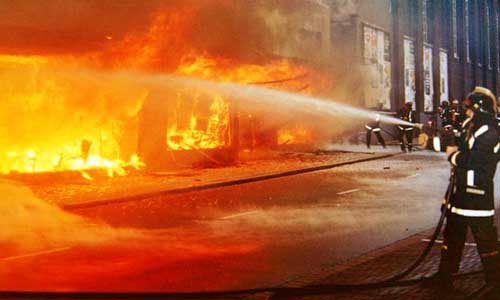 Terrorist attack in St. Gérard, November 6, 2005 In January 2006 Friland allowed gay marriage, following the Netherlands, Belgium, Spain and Canada. In Christian circles this decision met resistance but within the Ferna Sed religion of Friland people had less problems with it; for them marriage was an oath of fidelity between two lovers, no matter their gender. Pope Benedict XVI, who wasn't known for his enthusiasm about gay marriage, visited Friland and Hiveria on October 2006. To everybody's amazement the pope didn't mention the subject and king Waldrik also behaved diplomatically. The king later said about this matter that the papal visit was very important to the Catholic minority in Walamark and that he had therefore agreed with the pope not to quarrel in public, which is normally usual between Friland and the Vatican. Elections in Hiveria On February 3, 2007 presidential elections were held in Hiveria. To everybody's astonishment these were not won by big favorite Auguste Lenoir but by media tycoon Jean Collignon, with no less than 95% of the votes. This Soviet-like result raised suspicions that Collignon had committed fraud, but nothing could be proven and the media paid little attention to it. That Jean Collignon owned almost every tv station, newspaper and radio station in Hiveria undoubtly contributed to that. Less than a month after the installation of president Collignon opposition leader Auguste Lenoir was accused of fraud and sentenced to life imprisonment after a dubious trial. Friland decided to summon the Hiverian ambassador to ask for clarity about the state of affairs in its neighbouring country, but he refused to answer any question at all. The European Union eventually ended the admission negotiations with Hiveria and demanded that Collignon would allow new elections, which he refused. Economic crisis and terrorism In May 2008 two Frilandic aid workers were killed in a hostage situation in Afghanistan; three other hostages could be freed. The economic crisis also struck hard: in September 2008 the large bank Frilandiska Geldhod (FG) could barely be saved from bankruptcy by government support and in October 2008 there was a loss of jobs at ship builder Atlantiska Hwarban, the bankruptcy of supermarket chain Farainagița Berglaftiska Waranhusan (FBW) and remissions at both steel giant Iswalț stahl and the Hiverian car producer Pilat Voitures. 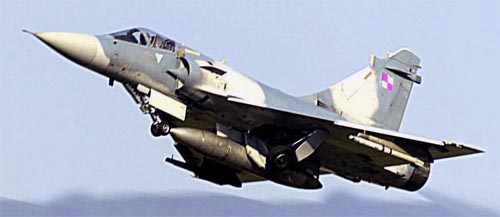 Mirage 2000 of the Hiverian air force Renewed tensions At the end of 2008 the tensions between Friland and Hiveria increased again due to Hiverian police violence against Frilanders in East Walamark and deliberate violations of Frilandic air space by Hiverian jet fighters. These last events eventually resulted in the Frilandic airforce shooting down a Hiverian Mirage 2000. Fifth Frilandic-Hiverian War Also known as the Birch Lane War (Berkangatkreig). On February 2, 2009 a firefight broke out between Hiverian border guards and Frilandic police officers in the Berkangat (Birch Lane), at the border between Frilandic West Runsburg and Hiverian East Runsburg. Later research concluded that the Hiverian border guards opened fire first, but the Hiverian president Collignon was convinced that it was a deliberate Frilandic attack and ordered his troops to invade the Frilandic part of Runsburg. West Runsburg, which was hardly defended, fell after two days of fighting. Hereafter the Hiverian army launched an offensive towards the west, in which the Dannanwalț and the hills between Runsburg and the Innansai were occupied. The Frilandic army, which was personally led by king Waldrik, fortified near Spirdung. From 5 to 9 February there was heavy fighting east of the city, until serious losses forced the Hiverian army to retreat to Runsburg. The battle of Spirdung hereby became a turning point in the war. East Walamark liberated The Frilandic army broke through to Runsburg and dealt another defeat to the Hiverian invasion army: on Februari 13 Runsburg was liberated and the Frilandic army marched into Hiverian East Walamark, where it was received as a liberator by the Frilandic population. On February 19 all of East Walamark was in Frilandic hands. 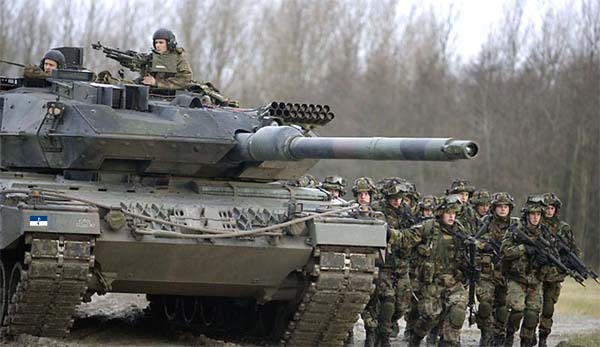 Frilandic soldiers march into East Walamark, February 13, 2009. Back to start
On March the 6th the referendum was held and the exit polls predicted a large majority in favour of a return to Friland. However, followers of president Collignon turned out to have committed large-scale fraud, causing East Walamark to remain a part of Hiveria with the incredible number of 90% of the votes. Completely unexpected the UN security council decided to accept the fraudulent result; that some of the influential members of the security council had close diplomatic relations with Hiveria, did, according to the UN, not play a decisive role in this. The Frilandic government was furious about the decision and a continuation of the war could only be prevented due to high pressure from the international community. Hiverian troops entered East Walamark and president Collignon reinstated his rule with iron fist, which restored the situation to what it was before the start of the war. With the difference that the already bad relationship between Friland and Hiveria had sunk to a freezing point. Cyber attacks and insurrections After the war, the conflict for East Walamark continued through other means. Cyber attacks, terror attacks and sabotage actions followed on both sides. In East Walamark there were regular escalations between the Hiverian government and Frilandic separatists, usually in the form of militias, who were provided with money and weapons by both sides. Second Kumangan Civil War In 2013, the short but bloody Second Kumangan Civil War took place. Ogunti rebels quickly conquered most of Kumanga and massacred the Frilandic minority in the northwest of the country. Due to the lack of a UN mandate to intervene, Friland secretly supplied weapons, ammunition, equipment and training to the Kumangan government army and the Frilandic-Kumangan Land Guard. There were also persistent rumors about the presence of Rikshar soldiers, who fought as volunteers against the Ogunti. Thanks to this (supposed) Frilandic support, Kumanga managed to hold out. When the UN finally allowed military action, US air strikes decided the civil war in favor of Kumangan democracy. Corona crisis The corona crisis raged from 2020 to 2022. There were many casualties in both Friland and Hiveria and both countries struggled with the balance between restrictions and relaxation. Hiveria opted for severe restrictions. Friland initially too, but soon relaxed. The corona policy caused discussion and increased tensions. First Frilander in space On September 21, 2022, astronaut Audwen Wulțssun became the first Frilander in space. He traveled on Soyuz Flight MS-22 to the International Space Station, where he performed repairs and scientific experiments. The flight was a collaboration between FRȚ, ESA, NASA and Roskosmos.  |
